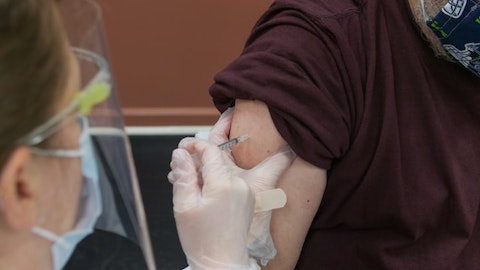Immunic, Inc. (NASDAQ:IMUX) Q4 2023 Earnings Call Transcript February 22, 2024
Immunic, Inc. beats earnings expectations. Reported EPS is $-0.48, expectations were $-0.51. IMUX isn’t one of the 30 most popular stocks among hedge funds at the end of the third quarter (see the details here).
Jessica Breu: Good morning to everybody on the line. I would like to welcome you to Immunic’s Fourth Quarter and Year End 2023 Earnings Call. My name is Jessica Breu, Vice President, Investor Relations and Communications at Immunic. I will also be the moderator today. Speaking on the call are Dr. Daniel Vitt, our Chief Executive Officer and President; as well as Glenn Whaley, our Chief Financial Officer. Please note that all participants will be in listen-only mode, and this event is being recorded. After today’s presentation, there will be an opportunity to ask questions. [Operator Instructions] Before we begin, I would like to remind you that this presentation may contain forward-looking statements. Such statements can be identified by words such as may, will, expect, anticipate, estimate or words with a similar meaning, and such statements involve a number of risks and uncertainties that could cause Immunic’s actual results to differ materially from those discussed here.
Please note that these forward-looking statements reflect Immunic’s opinions only as of the date of this presentation, and it undertakes no obligation to revise or publicly release the result of any revision to these forward-looking statements in light of new information or future events. Please refer to Immunic’s SEC filings for a more detailed description of the risk factors that may affect Immunic’s results and these forward-looking statements. I would now like to turn the call over to our CEO and President, Dr. Daniel Vitt, to begin the presentation. Daniel?

Daniel Vitt: Yes. Thank you, Jessica. I would also like to welcome everybody to today’s earnings call. Earlier this morning, we announced our financial results for the fourth quarter and the year ended December 31st, 2023, in our press release and Form 10-K. During the call today, we will walk through our fourth quarter’s 2023 achievements and subsequent highlights, year-end financial and operating results as well as anticipated upcoming milestones. As Jessica noted, after the presentation, you will have the opportunity to ask questions. Let’s start with a review of our fourth quarter 2023 and subsequent highlights. Punctuating our remarkable progress throughout 2023, we announced a three-tranche private placement of up to $240 million last month.
The round, led by BVF Partners, included participation from a group of top tier new and existing investors, including Avidity Partners, Janus Henderson Investors, Soleus Capital, RTW Investments and Adage Capital Partners. We received a total of $75 million in net proceeds from the first tranche, which closed on January 8th, 2024. The second and third tranches of $80 million each are conditioned on the announcement of Phase IIb top line data for our CALLIPER trial expected in April 2025, volume weighted average share price levels and minimum trading volumes. Any of these conditions in the second or third tranche can be waived by holders of a majority of the outstanding securities, including the lead investor. This financing completed in a challenging capital markets environment and with such a strong group of investors confirms the enormous value inherent in our two advanced clinical programs.
In October, we reported overwhelmingly positive interim data from the Phase II CALLIPER trial of our potentially groundbreaking lead asset, nuclear receptor-related one over one activator, vidofludimus calcium, in progressive multiple sclerosis, or PMS. In total, 203 patients were included in this analysis. The overall population, which includes all subtypes of PMS, saw a 22.4% improvement in serum neurofilament light chain, or NfL, for vidofludimus calcium over placebo at week 24. We believe that this is a substantial and meaningful difference in favor of vidofludimus calcium in this PMS population. Even a statistically significant difference was found for arithmetic mean serum NfL levels at week 24 between vidofludimus calcium and placebo with a p-value of 0.01.
See also 35 Top Paying Jobs in America and 35 Most Visited Countries in the World: 2024 Rankings.
Q&A Session
Follow Immunic Inc. (NASDAQ:IMUX)
Follow Immunic Inc. (NASDAQ:IMUX)
If you look at the subtypes of PMS to the right, you can appreciate that this difference in serum NfL at week 24 was consistently observed across all progressive MS subtypes. I would like to point out that we saw a 20.1% reduction of vidofludimus calcium versus placebo in advanced SPMS, meaning the patients with no focal inflammatory activity, but continued to cease progression. We believe this subtype is a segment of very high unmet need in MS with no relevant FDA approved therapies available in the United States. This next slide puts our CALLIPER interim data into this perspective of historical third-party studies in the same progressive MS subtypes. On the left, we displayed the data for PPMS compared to the ORATORIO study for ocrelizumab, which showed a spread of NfL values between active and placebo at 24 weeks of 12.4%.
In the CALLIPER trial, we observed an 18.8% improvement of active drug over placebo in PPMS at week 24. You may recall that the results of the ORATORIO Phase III study led to the approval of ocrelizumab for treatment of PPMS. In the center of this slide, you see historical data for the secondary progressive MS, both for inflammatory, non-active and active SPMS. In comparison, vidofludimus calcium was able to show a substantial reduction in NfL in both subpopulations. To our knowledge, this is the first time that such a substantial effect in NfL has been shown in non-active SPMS patients, again, which is the PMS subtypes which is the highest unmet medical need. The right side of the slide shows the comparison between our Phase II EMPhASIS data for vidofludimus calcium in RRMS versus historical relapsing MS studies to complete the picture.
In summary, we believe the clear separation observed in serum NfL for vidofludimus calcium over placebo in this PMS patient population as well as its subtypes represent another significant step forward for what could potentially be a first-in-class Nurr1 activator for MS. This strong signal also points to a more likely positive outcome of the overall CALLIPER trial as well as clinically relevant endpoints like prevention of disability worsening. Also in October, Dr. Bob Fox from Cleveland Clinic, who is the coordinating investigator of our ENSURE and CALLIPER programs, presented data from our Phase II EMPhASIS trial of vidofludimus calcium in RRMS in an e-poster at the Joint ECTRIMS-ACTRIMS Meeting. It is important to reiterate that vidofludimus calcium showed an improvement on serum NfL in both treatment arms of 30 and 45 milligrams over placebo.
In November, we were granted two fundamental new patents for vidofludimus calcium in the United States. The first covers a daily dose of about 10 milligram to 45 milligram of vidofludimus calcium and other salt as well as free acid forms for the treatment of relapsing MS, including the 30 milligram dosage used in our ongoing twin Phase III ENSURE trails. The second patent granted covers the dosing regimen associated with vidofludimus calcium and other salts as well as the free acid forms for the treatment of MS, including all regimens tested in our MS clinical program. As a result, our extensive patent portfolio now provides protection into 2041 or even beyond in the United States. Turning to our second key program, IMU-856, an orally available and systemically acting small molecule modulator that targets SIRT6 protein.
In October, we presented two abstracts at the United European Gastroenterology Week 2023. My colleague, Dr. Franziska Burianek, Senior Medical Director at Immunic, presented data from our Phase Ib clinical trial of IMU-856 in patients with celiac disease during a moderated poster session. The trial results gathered during periods of gluten-free diet and gluten challenge demonstrated meaningful improvement over placebo in four key dimensions of celiac disease of the physiology. Histology, disease symptoms, biomarkers and nutrient absorption. IMU-856 was also observed to be safe and well tolerated in this trial. Additionally, Dr. Geert R. D’Haens from Amsterdam University Medical Center, presented data from our Phase II CALDOSE-1 trial of vidofludimus calcium in ulcerative colitis, or UC.
As a reminder, the maintenance phase results from the CALDOSE-1 trial demonstrated statistically significant activity of vidofludimus calcium compared to placebo and reaffirmed the drug’s favorable safety and tolerability profile. The data validated the potential of vidofludimus calcium in UC and other inflammatory bowel disease indications. In November, we were pleased that Dr. Burianek had another opportunity to present the data from our Phase Ib clinical trial of IMU-856 in patients with celiac disease in a virtual e-poster at the Association of European Celiac Society General Assembly Conference in Athens, Greece. That concludes our summary of the fourth quarter 2023 and most recent highlights. I’m very pleased with the scientific and clinical advancements we have made across our different programs, and we are leveraging this momentum going forward.
As an example, for vidofludimus calcium, the release of our overwhelmingly positive biomarker NfL data has been an impetus for partnering discussions and global and regional pharmaceutical companies. There is also a lot going on with our IMU-856 program, which we will update you as progress is made this year. I would now like to turn the call over to Glenn to provide a financial overview. Glenn?



